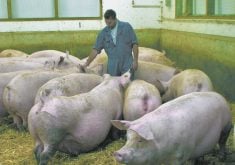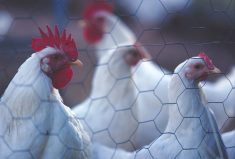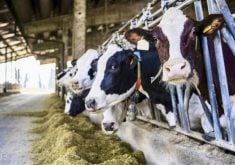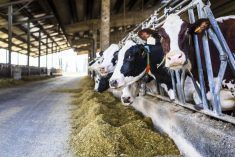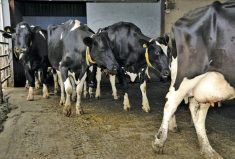If dairy producers want to use genomics to improve their herds, they should have a plan, develop goals for their operation, and stick to them, according to Gary Markus of Markhill Holsteins.
“Jump in with both feet, use the data, and don’t dabble,” he said during a producer panel on Dairy Day at the recent Grey-Bruce Farmers Week in Elmwood.
Markus and his wife Hilary have a 180-acre farm in southwest Oxford, hold 90 kilograms of quota and own 140 Holsteins. He also works full-time with Alta Genetics as a reproduction and genetics consultant.
Read Also

BinSentry sensors reduce feed-bin outages
BinSentry sensors mean fewer feed bin outages and more efficient deliver for feed mills.
Why it matters: Dairy producers using genomics can make earlier decisions on longevity, reproductive traits, milk production and quality.
More and more producers are getting their cattle genotyped, according to Lynsay Beavers, industry liaison co-ordinator for the Canadian Dairy Network.
She said that in 2017, close to 70 per cent of females were sired by genotyped young bulls in Canada, and that number is growing. On the female side, 40,000 Holsteins were genotyped. A total of 13 per cent of registered animals are being genotyped.
Genotyping involves taking genetic material from either the tissue or hair of the animal and performing DNA testing to find out its genetic potential. It’s a management tool that helps producers select cattle for traits that will improve the health and efficiency of their herds.
“We’ve doubled our rate of genetic progress since 2009, when it started,” she said, adding that the reliability of predictions for genetic potential since genomics was introduced has increased from 35 per cent under parent average (PA) to 70 per cent.
Markus believes in planning. His genomic plan is aimed at turning over his herd inventory of old genetics with high-end offspring from top females. He’s also determined to mitigate the costs and risks of buying high-end animals and wants to create 20 offspring from each purchase.
He and Wayne Wagler of Claynook Farms Ltd. agreed that spending more money almost always results in more profitability.
Wagler has an 800-acre farm near New Hamburg with 200 cows. The operation sells bulls and embryos around the world. He’s been using genomics since its inception.
“We wanted to stay at the leading edge of genomics,” he said. “We wanted to know if we had the stuff or if we needed to buy it,” he said.
He, too, is a firm believer and tests 80 per cent of the females born on the farm and 70 per cent of his males.
“We have higher conformation and better conception — we use exclusively genomic young sires in the herd,” he said. “We trust the LPI (Lifetime Performance Index) system more than any other worldwide, and that’s because of the data collection.”
Wagler pointed out that among the challenges in genomics is the need to determine more of the recessive traits that cause disease and failure to thrive. He also said that there remains a wide range of variability, even though genomics has raised the bar to 70 per cent reliability.
Phil Armstrong has 1,300 mostly rented acres north of Brampton. He has 375 cows with 300 replacements. He milks three times, averaging 42 to 43 kilograms per cow a day, and has three full-time and six part-time employees.
Before he started with genomics, he culled 25 to 30 per cent of his poorest performing heifers before breeding, using parent averages and indices as well as help from EastGen professionals to select them visually. He started testing 10 years ago, beginning with nasal swabs and has since switched to tissue samples.
Currently, he is culling animals that have a score of less than 2800 Genomic Lifetime Performance Index, and he said that means they’re getting rid of “a lot of good animals.”
In terms of results, over the years, his milk production, butterfat and protein have all consistently increased. He also selects for other traits like daughter fertility and calving ease.
“They’ve got to be able to calve,” he said.
Genomic testing prices dropping
Beavers said that the cost of genomic testing was recently reduced and advised that, for most producers’ purposes, a $33, low-density panel would be adequate. Testing is available from Holstein Canada, as well as a number of other sources.
The timing for testing is up to the producer, but she said that many do it as a part of their standard operation procedure for every animal after birth, taking a notch out of the ear when the tag goes in. Others look at the heifer’s Parent Average (PA) and check it against the LPI and then decided whether or not to test.
“The thing with a genomic test is that it carries on with her through her entire life — you pay that $33 once, and the genomic evaluation stays with her forever,” she said.
This makes management decisions down the road more accurate than using the PA alone.
As to why producers should test their animals, Beavers said that Genomic Parent Average (GPA) is superior to PA for heifer selection because it helps identify negative genetic recessives like low fertility, complex vertebral malformation (CVM), positive recessives like polled, it provides more accurate information for breeding and the heifer GPA better predicts future cow performance.
Beavers cautioned that it’s important to look at the actual animal as well as the genetic data.
“If you’re looking at a piece of paper with excellent results and you go in the barn and see an animal that’s had a terrible bout of pneumonia, she’s not going to live up to her genetic potential.”




